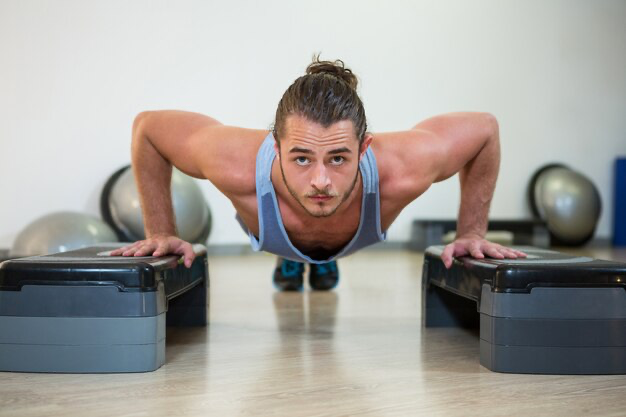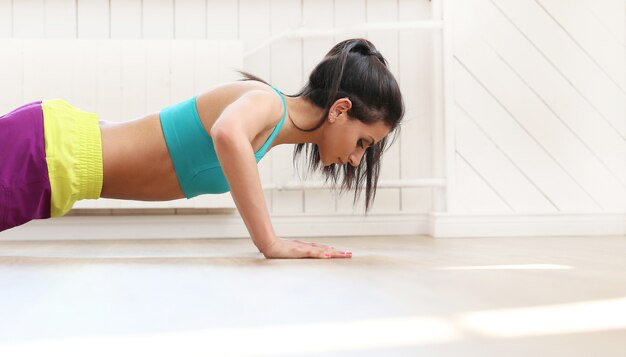Push-ups, a cornerstone of most fitness regimes, are beloved for their simplicity and the remarkable results they yield. Yet, the question lingers: Can the humble push-up contribute towards weight loss? Let’s delve into an in-depth exploration of push-ups and their potential role in helping you trim down.
The Power of Compound Exercises
The potency of a push-up lies in its nature as a compound exercise, which implies its ability to mobilize various muscle groups at once. It primarily focuses on the pectoral (chest) muscles, deltoids (shoulders), triceps (upper arm), and the entire core region. This orchestration of multiple muscles results in a higher caloric expenditure during the workout, enhancing its utility for weight loss. However, the question remains: Can push-ups alone bring about significant weight loss?
Push-ups are indeed a powerful asset for burning calories, but they might not be a standalone solution for weight loss. To put things in perspective, burning off a single pound necessitates performing approximately 500 push-ups!
Transforming Calories into Weight Loss: The Push-Ups Advantage
At the core of weight loss lies a simple mathematical truth: the calories you burn must surpass the calories you consume. This calorie deficit is the foundation upon which most weight loss plans are built. All physical exercises, including push-ups, play a crucial role in setting up this calorie deficit.
However, the rate of calorie burn varies based on several variables:
| Factor | Description |
|---|---|
| Intensity | The vigor and energy you put into your push-ups play a significant role in calorie burn. A high-intensity routine will burn more calories than a low-intensity one. It’s akin to the difference between a sprint and a jog. |
| Duration | The longer you engage in an activity, the more calories you burn. Extended push-up sessions will naturally burn more than quick sets. However, balancing duration with intensity is crucial to avoid overexertion. |
| Body Weight | Body weight significantly influences caloric burn. Heavier individuals use more energy to move, resulting in higher calorie expenditure. This is evident in activities like walking or running. |
| Technique | Proper push-up form ensures maximum muscle engagement and efficiency, impacting calorie burn. Incorrect technique can decrease the exercise’s effectiveness and elevate injury risk. |
For a more concrete understanding, take into account the fact that an average individual burns approximately 7 calories per minute while doing push-ups. This implies that a 10-minute session of push-ups can torch up to 70 calories. However, this is a rough estimate and actual figures may fluctuate depending on the variables discussed earlier.
Unraveling the Weight Loss Mystery: Can Push-ups Tip the Scale?
While push-ups undoubtedly pack a punch in boosting fitness, their efficacy as a standalone weight loss solution may not be as pronounced. Here’s a nuanced look at why:
- Translating Calories into Weight Loss: Compared to cardio-based exercises like running, swimming, or biking that engage large muscles and heighten heart rate, the calorie expenditure of push-ups tends to be moderate. These cardio exercises typically burn more calories per minute, thereby edging out strength-building exercises like push-ups, which, while crucial for muscle development, don’t torch as many calories;
- Building Muscle vs. Burning Fat: Push-ups act predominantly as a strength training exercise, aiding in muscle development. Muscle tissues, given their metabolically active nature, burn calories even during rest periods. Thus, muscle building can potentially raise rest metabolism rates, translating into long-term benefits. However, it’s important to note that these results might not be instantly noticeable as weight loss on the scale, particularly in the early stages;
- Body Adaptation: The human body is a marvel of adaptation. At the onset of any new fitness regime, you might witness an encouraging calorie burn and muscle fatigue. However, as the body adjusts to the new exercise routine over time, it evolves to perform the same exercise with lesser energy, thereby reducing caloric burn. As such, fitness enthusiasts often advocate for regular changes in workout routines to keep challenging the body and prevent this adaptation effect.
Reframing the Question: Quantity or Quality of Push-ups?
The prospect of push-ups as a weight-loss panacea might have taken a hit, but that doesn’t mean they should be abandoned altogether. Push-ups, with their multifaceted benefits, still hold considerable merit in a weight loss plan. Keeping in mind the average 7 calories burned per minute, it would indeed take a mammoth effort of roughly 500 minutes of continuous push-ups to shed a pound, steering us away from relying solely on push-ups for weight loss.
However, it’s important to pivot the conversation from “how many” to “how well.” Quality and consistency should supersede quantity. Here are some key pointers to optimize your push-up routine:
- Consistent Commitment: The cornerstone of any fitness regimen is consistency. Create a goal that’s practical for your lifestyle, whether it’s 20 push-ups a day or 100, and stick to it. The collective impact of regular exercise speaks louder than sporadic, high-intensity sessions;
- Diverse Routine: In the pursuit of overall fitness, vary your workouts. Blend strength training exercises like push-ups with cardio exercises such as running, cycling, or swimming. This approach not only amplifies calorie burn but also fosters holistic fitness by working out different muscle groups;
- Perfect the Form: The effectiveness of push-ups hinges on proper form. Reaping benefits from fewer push-ups done correctly far outweighs the limited gains from a multitude of poorly executed push-ups. Remember, in the world of push-ups, quality trumps quantity.

Weight Loss: Unpacking the Role of Push-ups and Beyond
The journey to shedding excess weight is a comprehensive endeavor that requires a well-rounded approach. Just as a single piece of a jigsaw puzzle doesn’t complete the picture, relying entirely on push-ups for weight loss might not provide the desired results.
Here’s a broader look into the various facets of weight loss:
Diet: Your First Step Towards Weight Loss
- Significance: The seesaw of calorie intake and expenditure determines your weight trajectory. Consuming more calories than burning results in weight gain, while burning more calories than consuming leads to weight loss. Hence, your food choices are instrumental in your weight loss journey;
- Balanced Diet: A diet balanced in proteins, carbohydrates, fats, vitamins, and minerals work wonders for your body. Nutrient-rich food like vegetables, fruits, lean proteins, and whole grains not only keep you full but provide sustained energy too;
- Calorie Deficit: Along with nutritious food, keep a tab on your meal portions and overall calorie intake. A sustainable calorie deficit, where you burn more calories than you consume, is the magic formula for effective weight loss.
Cardio: The Calorie Torcher
- Why Cardio?: Cardio exercises are calorie-burning powerhouses. They jack-up your heart rate, improve lung function, and amp-up your cardiovascular health;
- Variety is Key: Keep your cardio routines interesting by shuffling between brisk walking, running, cycling, swimming, and dancing. Variety not only keeps you engaged but also challenges different muscle groups.
Strength Training: Push-ups and More
- Expand Your Horizon: While push-ups are an excellent strength training exercise, consider adding squats, lunges, deadlifts, and bench presses to your routine for a more comprehensive muscle workout;
- Metabolic Boost: More muscle tissue equals a higher resting metabolic rate. Simply put, you continue to burn calories even at rest.
Rest and Recovery: Your Body’s Repair Time
- The Power of Rest: Just like cars need periodic maintenance, your body needs its downtime. This recovery period is when your muscles repair and grow;
- Steer Clear of Overtraining: Overexerting your body without enough rest can lead to overtraining which not only stalls progress but can also increase the risk of injury;
- Active Recovery: Engage in low-intensity activities like walking or yoga on your rest days to aid in muscle recovery without overstraining your body.
Evaluating the Role of Leg Press Starting Weight
While push-ups claim their rightful place in the arsenal of weight loss endeavors, it’s crucial to explore the broader spectrum of strength training exercises. One such exercise is the leg press, often overlooked but with its unique merits. The leg press, whether performed on a machine or with free weights, targets the lower body, engaging muscles in the legs, hips, and lower back. Similar to push-ups, it contributes to muscle development and metabolism enhancement. However, when contemplating leg press starting weight, remember that quality and gradual progression take precedence over excessive loads. Starting with a manageable weight and gradually increasing it ensures a safe and effective strength training journey.
Conclusion
In sum, the key to successful weight loss lies in adopting a multidimensional strategy that extends beyond the realm of push-ups. A comprehensive blend of a balanced diet, diversified cardiovascular and strength training routines, enhanced by adequate rest and recovery, forms the blueprint to effective weight loss. While push-ups play a valuable role in muscular strength and metabolism boost, their most potent rewards are reaped when they complement a broader fitness plan. Hence, instead of focusing solely on push-ups for weight loss, view them as a cog in the larger wheel of holistic wellness, driving you toward a healthier, fitter life.
